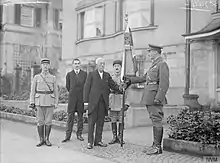Torquhil Matheson
General Sir Torquhil George Matheson, 5th Baronet, KCB, CMG (4 February 1871 − 13 November 1963) was a Scottish officer who commanded three different divisions of the British Army in some of the heaviest fighting of the First World War. He had previously served in the militia and with the Coldstream Guards in the Second Boer War. For his service, he was knighted in 1921 and in 1944 he inherited the Matheson baronetcy from his brother Roderick.[3]
Sir Torquhil Matheson | |
|---|---|
| Born | 4 February 1871 St George Hanover Square, London, England[1] |
| Died | 13 November 1963 (aged 92) Camberley, Surrey, England[2] |
| Allegiance | |
| Service/ | |
| Years of service | 1890−1935 |
| Rank | General |
| Unit | Bedfordshire Regiment Coldstream Guards |
| Commands held | 3rd Battalion, Coldstream Guards 46th Brigade 20th (Light) Division 4th Division Guards Division 7th Guards Brigade 7th Division 54th (East Anglian) Division Western Command, India |
| Battles/wars | Second Boer War First World War |
| Awards | Knight Commander of the Order of the Bath Companion of the Order of St Michael and St George |
Early life and family
Torquhil Matheson was born in February 1871, the youngest child of Sir Alexander Matheson, 1st Baronet, and was educated at Eton College. He inherited the baronetcy in 1944 when his four older brothers (including the 2nd, 3rd and 4th Baronets) predeceased him and three nephews (the 3rd Bt.'s only sons) were all killed in action in World War I.
In 1900 he married Ella Louisa Linton and they divorced in 1923 (no children). He then married Lady Elizabeth Keppel, the youngest child of Arnold Keppel, 8th Earl of Albemarle. They had two sons:
- Major Sir Torquhil Alexander Matheson of Matheson, 6th Bt. (15 Aug 1925–9 Apr 1993)
- Major Sir Fergus John Matheson of Matheson, 7th Bt. (b. 22 Feb 1927)
Military career
Matheson joined the Hertfordshire Militia before being commissioned as a second lieutenant into the Bedfordshire Regiment on 15 December 1888.[4] On 2 June 1894, Matheson transferred from the Bedfordshires, in which he was then a lieutenant, to the Coldstream Guards as a second lieutenant again,[5] and was promoted lieutenant in that regiment on 1 December 1897. He served in the Second Boer War, as adjutant of the 1st Battalion from 1899 until May 1902.[6] The battalion took part in the battles of Belmont (23 November 1899), Enslin, Modder River (28 November 1899) and Magersfontein (11 December 1899), and he was mentioned in despatches, and promoted to captain on 20 April 1901.[7] Following the end of the war in June 1902, Matheson left Cape Town in the SS Carisbrook Castle in September 1902, arriving at Southampton early the following month.[8]
At the outbreak of the First World War in August 1914, Matheson went with his regiment to France and fought in several actions, being promoted to lieutenant colonel in 1915 and taking command of the 3rd Battalion.[9]

In July 1915, Matheson advanced to command the 46th Brigade, part of the 15th (Scottish) Division, and remained in this position until March 1917, when he was promoted to major-general and took over the 20th (Light) Division. In August, shortly before the division was due to deploy in the Battle of Passchendaele, Matheson was severely effected by a German gas barrage that struck his headquarters, forcing him to relinquish control of the division. In September he took over the 4th Division, remaining in this position until September 1918, when he was replaced by Louis Lipsett and took charge of the Guards Division, which he led for the final months of the war until the armistice with Germany in November 1918, which ended hostilities.[9]
In 1918, Matheson was made a Companion of the Order of the Bath and the following year was awarded the Croix de Guerre[10] and appointed a Companion of the Order of St Michael and St George on relinquishing command of the Guards Division. In 1922, he was advanced to Knight Commander of the Order of the Bath "for valuable services rendered in the Field with the Waziristan Force"[11] and commanded the 7th Guards Brigade and then the 7th Infantry Division.[9] He then became General Officer Commanding (GOC) of the 54th (East Anglian) Division in February 1927.[12]
On 30 June 1931, he was appointed to his last command, as General Officer Commanding-in-Chief (GOC-in-C) Western Command, India,[13] and on 30 June 1935 retired from that post as a full General.[14] On 2 July 1935 he was gazetted to the Retired List,[15] and in 1944 succeeded to his grandfather's baronetcy on the death of his elder brother Roderick. He himself died in November 1963, at the age of 92.[9]
References
- 1871 England Census
- "Obituary: Gen. Sir Torquhil Matheson – The Army in India". The Times. 14 November 1963. p. 16.
- Mosley, Charles, ed. (2003). Burke's Peerage, Baronetage & Knighthood (107 ed.). Burke's Peerage & Gentry. p. 2645. ISBN 0-9711966-2-1.
- "No. 25883". The London Gazette. 14 December 1888. p. 7141.
- "No. 26518". The London Gazette. 1 June 1894. p. 3190.
- "No. 27454". The London Gazette. 15 July 1902. p. 4511.
- Hart 1903, p. 221.
- "The Army in South Africa - Troops returning Home". The Times. No. 36882. London. 25 September 1902. p. 5.
- Davies & Maddocks 2014, pp. 166–167.
- "No. 31514". The London Gazette. 19 August 1919. pp. 10607–10608.
- "No. 32778". The London Gazette. 19 December 1922. p. 8949.
- "Army Commands" (PDF). Retrieved 4 June 2020.
- "No. 33748". The London Gazette. 28 August 1931. p. 5626.
- "No. 34188". The London Gazette. 9 August 1935. p. 5109.
- "No. 34176". The London Gazette. 2 July 1935. p. 4258.
Bibliography
- Davies, Frank; Maddocks, Graham (2014). Bloody Red Tabs: General Officer Casualties of the Great War 1914-1918. Pen and Sword. ISBN 978-1-4738-1251-2.
- Hart, H.G. (1903). Hart's Annual Army List. Vol. 64. London: John Murray.